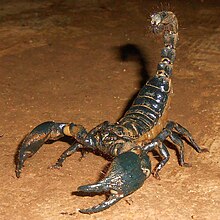Scorpionyssus heterometrus
| Scorpionyssus heterometrus | ||||||||||||
|---|---|---|---|---|---|---|---|---|---|---|---|---|
| Systematics | ||||||||||||
|
||||||||||||
| Scientific name of the genus | ||||||||||||
| Scorpionyssus | ||||||||||||
| Fain & Rack , 1988 | ||||||||||||
| Scientific name of the species | ||||||||||||
| Scorpionyssus heterometrus | ||||||||||||
| Fain & Rack , 1988 |
Scorpionyssus heterometrus is a predatory mite of the Laelapidae family that is widespreadin Sri Lanka and has been found on scorpions of the species Heterometrus swammerdami .
description
Genus Scorpionyssus
Adult specimens of the genus Scorpionyssus have an oval body that is widened at the abdomen. The edges of the opisthosoma are clearly raised. The back is covered with a large shield on which there are about 19 pairs of Setae. The setae standing on the edge are relatively long, thick and curved or wavy. The setae in the middle of the shield are very short and thin. The breastplate has a greatly reduced size. The genital operculum is relatively small and has no setae. The legs are short and strong, they end in large suction cups and only slightly sclerotized claws. The chelicerae of female mites are long, with a shortened fixed and a significantly longer mobile claw. In male mites, the chelicerae are shorter, with a very short and thin firm claw. The movable claw is about twice as long and significantly thicker.
The deutonymphs have a small abdominal shield, the rear edge of which does not reach the coxae of the fourth pair of legs and carries a pair of setae in the rear part. They have a one-piece back shield. The protonymphs differ from the deutonymphs in their back shield, which is divided into two large central shields and two small edge shields. In addition, their chelicerae are shorter.
The structure of the chelicerae of the larvae is similar to that of the adult female mite, but they are shorter. The larvae lack the ventral and back shields. They carry 12 pairs of short setae on their backs.
Scorpionyssus heterometrus
There are 18 to 20 pairs of Setae on the back shield, in most cases 19 pairs. Female mites are 730 to 870 micrometers in length and 480 to 630 micrometers wide at the widest point of the abdomen. Their chelicerae are 180 micrometers long, measured to the end of the firm claw. Male mites are 525 to 555 micrometers long and 330 to 345 micrometers wide, with a chelicerae length of 130 micrometers.
The deutonymphs are 555 to 630 micrometers long and 325 to 375 micrometers wide. The protonymphs are 400 to 500 micrometers long and 255 to 290 micrometers wide. The larvae are approximately 440 micrometers long and 270 micrometers wide.
distribution
The Terra typica of Scorpionyssus Heterometrus is a rubber plantation in Hiniduma ( 6 ° 18 '45.4 " N , 80 ° 18' 41.8" O ) in Galle district of Southern Province of Sri Lanka. Nothing further is known about the distribution area.
Way of life
Scorpionyssus heterometrus has so far only been found parasitic on two specimens of scorpions of the species Heterometrus swammerdami . In both infected scorpions, around 50 mites in different stages of development were found below the coxae of the first pair of legs. Neither the frequency of the infestation of these scorpions nor any other hosts are available.
Systematics
The monotypical genus Scorpionyssus belongs to the predatory mites and thus in the parentage Parasitiformes of the subclass mites . Scorpionyssus is closely related to the genus Ljunghia , the species of which have been found parasitizing on spiders in Sumatra and South Australia. Because of several similar morphological features of Scorpionyssus heterometrus , it appears to be more closely related to the South Australian species of Ljunghia .
So far only a few mites have been found that parasitize on scorpions. Among them, Scorpionyssus hetereometrus is the only representative of the order Mesostigmata .
Initial description
The first description of Scorpionyssus Heterometrus was made in 1988 by the Parasitologen Alex Fain from the Royal Belgian Institute of Natural Sciences and Gisela rack from the Arachnologische collection of the Zoological Museum of Hamburg . For this they had two infected scorpions of the species Heterometrus swammerdami with around 200 mites in all stages of development.
etymology
The species name heterometrus refers to the only known host, scorpions of the genus Heterometrus .
Types
The type species of the genus Scorpionyssus is their only species, Scorpionyssus heterometrus . The holotype of Scorpionyssus heterometrus is an adult female mite from the locality. 30 female and 18 male adult mites as well as 20 deutonymphs, 14 protonymphs and six larvae were defined as paratypes . In addition to the holotype, there are 52 paratypes in all stages and other specimens in the Hamburg Zoological Museum. The Royal Belgian Institute for Natural Sciences in Brussels received 32 paratypes in all stages for its collection. Further paratypes are a female and a male mite, a deutonymph and a protonymph in the Natural History Museum in London.
literature
- Alex Fain and Gisela Rack: Scorpionyssus heterometrus gen. N., Sp. n. (Acari, Laelapidae) parasitic on a scorpion from Sri Lanka . In: Entomologische Mitteilungen from the Zoological Museum Hamburg 1988, Volume 9, No. 132, pp. 99-108, online PDF , 344 kB.
Individual evidence
- ↑ a b c d Alex Fain and Gisela Rack: Scorpionyssus heterometrus gen. N., Sp. n. , p. 99.
- ↑ a b Alex Fain and Gisela Rack: Scorpionyssus heterometrus gen. N., Sp. n. , p. 101.
- ↑ Alex Fain and Gisela Rack: Scorpionyssus heterometrus gen. N., Sp. n. , pp. 101-102.
- ↑ a b c Alex Fain and Gisela Rack: Scorpionyssus heterometrus gen. N., Sp. n. , p. 102.
- ↑ a b Alex Fain and Gisela Rack: Scorpionyssus heterometrus gen. N., Sp. n. , p. 107.
- ↑ a b c d e Alex Fain and Gisela Rack: Scorpionyssus heterometrus gen. N., Sp. n. , p. 108.
